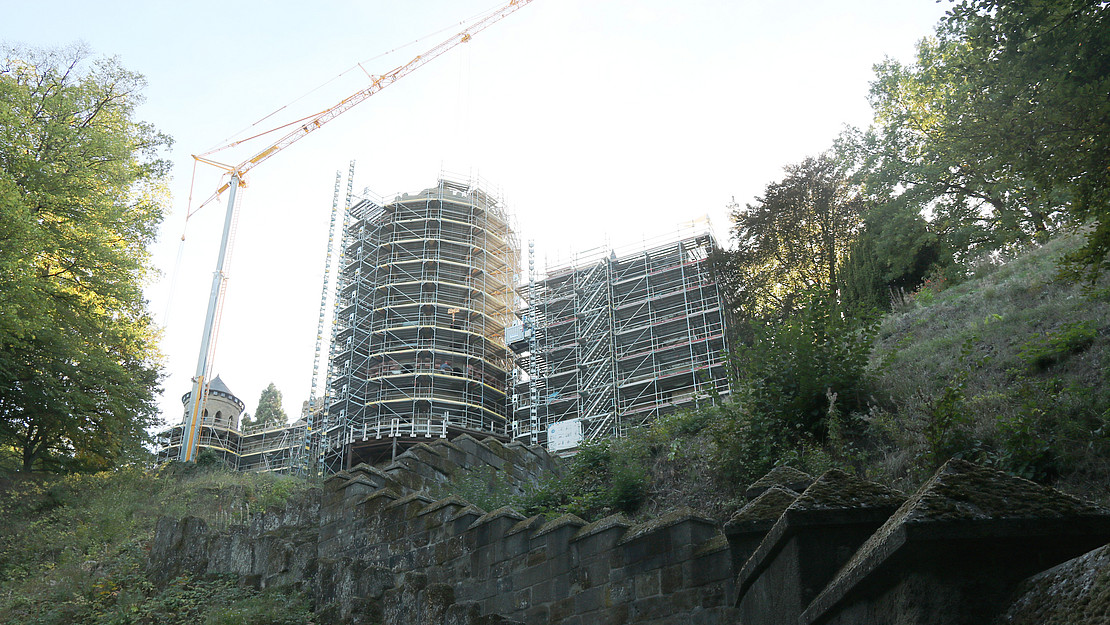This page contains automatically translated content.
Invention with a view
 Image: University of Kassel
Image: University of KasselIt is the restoration of a ruin to its ruinous original state - but what a building it is! The state of Hesse is currently restoring the Löwenburg in Bergpark Wilhelmshöhe at a cost of around 30 million euros. The keep, which has grown 30 meters in height over the past two and a half years, is the showpiece, visible from afar, and now stands as it did before its destruction in World War II. Final work on the facade is taking place these weeks.
This was made possible by a material science invention from the University of Kassel: artificial tuff. When architect Heinrich Christoph Jussow built the pleasure palace in the late 18th century for Landgrave Wilhelm IX of Hesse-Kassel, he created an enchanting replica of a medieval castle ruin and a highly significant building in terms of art history - and saddled posterity with a whole host of problems. Jussow chose Habichtswald tuff as the building material. The dark, rapidly weathering rock emphasized the romantic character of the ruins, was available nearby and easy to work, but was actually unsuitable as a building material: After only a short time, the tuff stone began to crumble, and since then the Löwenburg has been in constant need of renovation. In the last days of the Second World War, an American aerial bomb reduced the proud main tower to its stump. The faithful reconstruction was made possible by a development of Peter Machner, former head of the official Materialprüfungsanstalt AMPA at the University of Kassel: "Up to 80 percent waste is produced during the extraction of tuff," he explains. In a series of tests, Machner developed an artificial stone, ultimately a concrete, in which crushed tuff waste takes on the role of aggregate. The Landesbetrieb Bau und Immobilien Hessen,
the Museumslandschaft Hessen Kassel, the Landesamt für Denkmalpflege (State Office for the Preservation of Monuments) as well as freelance stone restorers and contractors contributed to the fact that the artificial tuff is now helping the Löwenburg.
"Neither in terms of its stone-technical properties nor its optical qualities" does it have to fear comparison with natural stone, judges the catalog of the Museumslandschaft Hessen-Kassel on the Löwenburg. On the contrary: it is more weather-resistant and stronger, and on top of that it solves another problem: the genuine Habichtswald tuff is running out, the quarries in the region are almost exhausted. Without the artificial supply, the restoration would have been difficult. All 4500 stones of the tower are unique specimens. Historical documents provided the location and dimensions of each block, which were then first created as a 3-D model in the computer.
A Thuringian company produced the stones, and AMPA itself checked the material quality. With the development and practicality of the Art Tuff, the prospects for future restorations on other buildings in the Bergpark have also improved. This is the third time that the keep has been resurrected: the first, inadequate
structure lasted only 50 years, while the second was more solid and lasted until 1945. In the coming years, builders will reconstruct the interior of the tower and also restore
large parts of the rest of the Löwenburg. When it reopens around 2022, the four-story tower will initially present visitors with the library, and later with the Knights' Hall and the historic dining room. Visitors will then be able to access an observation deck and enjoy a spectacular view of Bergpark
and the city of Kassel. Invention with a view The keep of Löwenburg Castle has been resurrected - thanks in part to inventiveness from the university AMPA tests mineral and metallic materials on behalf of private and public clients, analyzes damage, examines the condition of structures made of steel, concrete, masonry and
draws up repair concepts. A relatively new area of work is the monitoring of onshore and offshore wind turbines.
This article appeared in publik 4/2018 (Dec. 18, 2018).
By Sebastian Mense